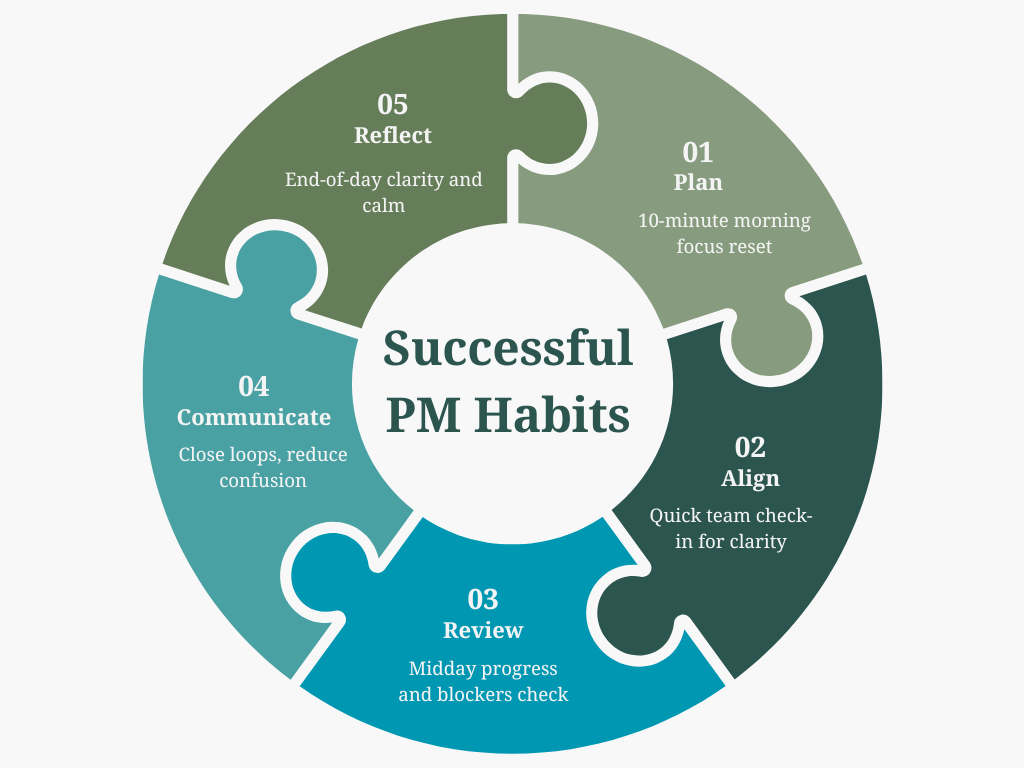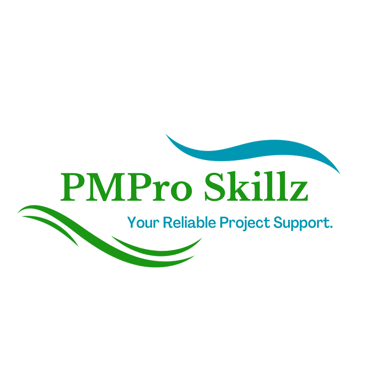Project Manager's Daily Routine: 5 Habits That Keep Chaos in Check
Discover 5 daily habits project managers use to stay calm, focused, and in control, even when projects shift and chaos hits.
Iyanna Trimmingham
10/11/20255 min read


You know that project manager who always seems calm? The one who responds to crises without panic, knows exactly where every project stands, and somehow leaves the office at a reasonable hour?
They're not superhuman. They're not working fewer hours than you. And they're definitely dealing with the same chaos; missed deadlines, shifting priorities, urgent stakeholder requests, team conflicts.
The difference? They have a system.
While many PMs are swept along by the day's urgencies, the best ones have built a routine that creates pockets of control in the chaos. It's not complicated. It's not time-consuming. It's five specific habits that take less than an hour total but change everything about how their days unfold.
Why Many PM Routines Fail
Before we dive into what works, let's talk about why most daily routines fall apart.
You've probably tried the “perfect morning routine” advice before. Wake up at 5 AM. Meditate. Journal. Review your goals. Plan your day in meticulous detail. Then reality hits. A vendor misses a deadline. A stakeholder changes requirements. Your team has a conflict that needs immediate attention. Your beautiful routine crumbles by 9:30 AM.
The problem isn’t the habits themselves, it’s that they’re not designed for the unpredictable nature of project management. What you need are habits that work with chaos, not against it. Habits that take minutes, not hours. Habits that create stability even when everything around you is shifting.
Habit 1: The Morning Anchor (10 Minutes)
Start your day with ten minutes of intentional planning before you open email or Slack.
Here’s what this looks like:
Review Your Calendar (2 minutes)
What meetings do you have today? What decisions need to be made? Who needs your input?Identify Your Big Three (3 minutes)
What are the three most important things that must get done today? Not the 15 items on your to-do list, just three. Write them down.Block Time for Deep Work (5 minutes)
Find one 60-90 minute block in your calendar and protect it. This is when you’ll tackle one of your Big Three. If your calendar is full, decline a meeting or move it. Your project needs your focused thinking, not just your attendance.
Why it works: You’re making proactive decisions about your time and priorities before the urgency of others hijacks your attention.
Habit 2: The Stand-Up Check-In (15 Minutes)
Whether your team is remote, hybrid, or in-office, a quick daily stand-up keeps everyone aligned and unblocked.
Here’s the format that actually works:
Each team member shares three things:
What I completed yesterday
What I’m working on today
What’s blocking me
That’s it. No long explanations. No solving problems in the meeting. If something needs deeper discussion, take it offline.
The golden rule: Keep it to 15 minutes maximum. If you’re going over, your stand-up has turned into a status meeting, and you’ve lost the benefit.
Pro tip: Do this at the same time every day; 9 AM or 10 AM works well. Consistency creates accountability and rhythm for your team.
Why it works: You catch issues early when they’re small. You know exactly where your project stands without chasing people for updates. Your team feels connected and supported.
Habit 3: The Midday Pulse Check (5 Minutes)
Around noon or 1 PM, take five minutes to check your project’s vital signs.
Pull up your project dashboard or tracker and ask yourself:
Are we on track for today’s milestones?
Did any new risks or issues surface this morning?
Is anyone stuck or waiting on me?
This isn’t about deep analysis, it’s about awareness. You’re taking the pulse of your project to catch anything that might derail your afternoon.
If something’s off, you have time to course-correct before the end of the day.
Why it works: Most project problems don’t announce themselves with sirens. They show up as small delays or quiet blockers. The midday pulse check catches them while they’re still manageable, like a built-in Pause & Process moment to realign and refocus.
Habit 4: The Closed-Loop Communication Review (10 Minutes)
Here’s where projects go sideways: someone thought they communicated something clearly, but the message got lost, misunderstood, or never seen.
Once a day, review your communication channels: email, Slack, Teams, project management tools, and close any open loops.
Look for:
Questions you haven’t answered
Decisions that need confirmation
Requests waiting for your response
Information you promised to send but didn’t
Set a timer for ten minutes. Work through as many as you can. For anything that requires more time, add it to tomorrow’s Big Three or schedule a specific time to handle it.
The key insight: Unanswered communication creates uncertainty. Uncertainty creates anxiety. Anxiety creates chaos. Closing loops creates clarity.
Why it works: You build a reputation for responsiveness and reliability. Your team knows they can count on you. Stakeholders trust that nothing falls through the cracks.
Habit 5: The End-of-Day Review (10 Minutes)
Before you close your laptop, spend ten minutes wrapping up your day intentionally.
Here’s your end-of-day checklist:
Celebrate Wins (2 minutes)
What went well today? What did your team accomplish? Write it down. This isn’t fluffy self-help, it’s critical for maintaining momentum and morale.Capture Tomorrow’s Big Three (3 minutes)
What are the three most important things for tomorrow? Get them out of your head and onto paper so you’re not thinking about work all evening.Clear Your Mental Inbox (5 minutes)
Any thoughts, worries, or ideas floating around? Do a quick brain dump. If something needs action, add it to your task list. If it’s just noise, let it go.
This ritual creates a boundary between work and life. You’re not just stopping work, you’re completing your day.
Why it works: You start tomorrow with clarity instead of confusion. You sleep better because your brain isn’t trying to remember everything. You maintain perspective on what actually matters.
The Compound Effect of Small Habits
Here’s what happens when you practice these five habits consistently:
Week One: You feel more in control. The constant firefighting decreases.
Week Four: Your team notices. They’re more aligned, less stressed, and blockers get resolved faster.
Week Twelve: Stakeholders see the difference. Projects run smoother. Communication is clearer. Trust deepens.
These habits take 50 minutes total per day. That’s less time than most people spend scrolling social media or sitting in one unnecessary meeting.
But the return is exponential. You’re not just managing projects, you’re creating sustainable systems that scale with complexity.
Making the Habits Stick
The biggest mistake people make is trying to adopt all five habits perfectly starting tomorrow.
Don’t do that!
Start with one. The Morning Anchor is usually the easiest entry point. Practice it for a week until it feels automatic. Then add the next habit.
Within a month, you’ll have a complete routine that keeps chaos in check without adding stress to your day.
A few tips to help them stick:
Set reminders on your phone for the first two weeks
Print out the habit checklist and keep it visible at your desk
Tell your team what you’re doing, they’ll help hold you accountable
Be flexible: if you miss a day, just start again the next morning
Your Challenge for Tomorrow
Tomorrow morning, before you do anything else, practice the Morning Anchor.
Ten minutes. Your calendar, your Big Three, and one protected time block.
That's it.
See how your day feels different when you start with intention instead of reaction.
Then come back and let me know: Which of these five habits will make the biggest difference in your routine? Drop a comment below!
Remember: chaos is the default state of projects. Structure is the habit you build, one small practice at a time.

